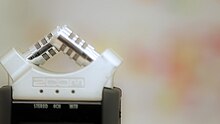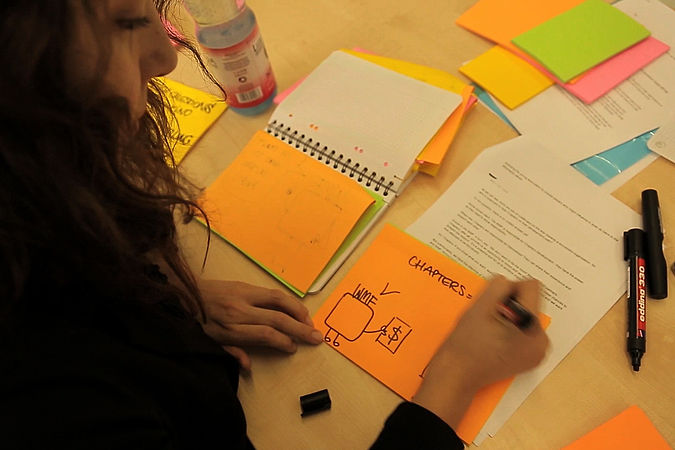Диалог на сдруженията/ Проект/ Внедряване
Внедряването на проектаРазбиранеЗа да даде възможност на Кира да извърши дълбоко потапяне в сложността на вселената Уикимедия, Никол подготви набор от документи, линкове и истории, проведе дълги монолози и свърза Кира с дългогодишни уикимедианци и колеги от Уикимедия Германия. За щастие, проектът за диалог на сдруженията можеше да се възползва от голямото количество данни, което вече съществуваше. Кира се 'зарови в различни източници на данни и събра входяща информация, въпроси и теми. Having a huge pool of contacts, information and documents is crucial at this stage, and was a basis for Nicole and Kira to use to create an extensive questionnaire that would cover all topics we wanted to focus on in the research. We also decided that we needed different questionnaires for Chapters and Stakeholders in order to ensure different roles and perspectives were accurately surveyed. It took some drafts and feedback-loops until we got the first version and were ready to start the interviews. Kira conducted the first interviews with stakeholders (one representative each from WMF and the Affiliations Committee) and fours Chapters (Wikimedia Australia, Estonia, South Africa and Taiwan) at Wikimania in Hong Kong in August 2013. We improved the research questions based on the feedback we gathered during our kick-off session at Wikimania, the first interviews and several one-on-one conversations. Наблюдение В основата на проекта са действителните интервюта: Кира интервюира доброволци и служители от сдруженията на Уикимедия, Фондация Уикимедия, Комитета за разпределение на средства и Комитета на филиалите, за да разбере какво има значение за всеки един от тях. За да стане това възможно, бе необходимо
 По време на проекта, трябваше да коригираме "датите на турнето" според възможността на интервюираните, сложността на самата материя, или други неочаквани събития. Гръбнакът на проект с такъв характер е професионалната и надеждна администрация. Подкрепата и участието на доброволци и служители на Уикимедия Германия, Фондация Уикимедия и участващите лица ни позволиха да се справим с логистиката. Видяхме голямо гостоприемство и ангажираност от всички краища на света. Кира трябваше да пропътува доста кирометри в хода на проучването. Тя трябваше да се приспособява към времеви зони, езици, климати и културни навици, убеждава охраната на летищата, че звукозаписният й рекордер не е оръжие, докато най-накрая достигне дестинацията: срещата й с интервюираните лице в лице. Това беше доста голямо приключение, а интервютата се провеждаха на най-различни места: офиси, фоайета на хотели, кафенета, ресторанти, през нощта в Зокало в Мексико Сити, по време на пътуване с влак и дори на пирамиди. Доказателство може да се намери в описанието Фейсбук диалог на сдруженията.
While an official interview lasted around 90 minutes, we always tried to spend some extra time with the interviewees, in their office with the rest of the team, at lunch or dinner or during a stroll through their hometown. This extra time was of significant importance, as many interesting aspects were revealed after the official interview was over – sometimes really the very minute after the sound recorder was switched off. During casual talk people tend to open up and provide either additional information that deepens the understanding of their story or even new and sometimes surprising aspects that didn’t come up during the interview at all. In addition, people who were not official interviewees had the chance to tell their version of the narrative. Even the smallest remark was sometimes really useful and uncovered valuable insights. For organisational reasons, some of the interviews were done via video conferencing. Even if we knew that a conference call would not deliver the same quality as a face-to-face interview, in some cases it was unavoidable. Our caution was confirmed: especially when meeting for the first time, a conference call can be a bit awkward (socially and technically). It is hard to create an atmosphere of trust, and it does not allow for extra “unofficial” time that is so valuable for the interviews. We therefore limited the number of video conferencing interviews to a minimum, but were glad that this gave us the chance to have additional and – nevertheless – valuable conversations. Either way, Kira worked through the travel and interview schedule and dug deep into the trials and tribulations of the Wikimedia universe. Countless notebooks (paper ones!) were filled, new questions arose, hundreds of topics were discussed, and the quantity of stories grew steadily. Between September 2013 and March 2014, she had collected personal stories from 94 individuals. Iteration and participationA very important aspect of Design Thinking is its iterative character. Everything from tools to ideas and prototypes can and should be adjusted or completely changed based on what is learned during the process. This approach fitted very well with the openness of the Wikimedia movement and the working culture at Wikimedia Deutschland. It provided the Chapters Dialogue team with a lot of flexibility and enabled us to iterate the research design and steadily improve its quality. We wanted to conduct the research project in an open and transparent way, calling on all the Chapters and interested people for active participation. Iteration meant for us:

Instead of just setting up Meta pages and getting lost in endless mailing list discussions we went for a coordinated and structured approach. Staying flexible, adjusting throughout the process and allowing participation were the keys for this project smoothly and successfully running in a professional way. СинтезСинтезът е най-трудната част от проекта. Размерът на данните и информацията, която събрахме в изследователската фаза, беше огромен. От март до окончателното представяне на 11 април 2014 г., Кира документира ключовите изказвания и истории от интервютата на ръкописни бележки, ние записахме със звук почти всички интервюта (подлежащи на одобрение от анкетираните) и ги преведохме. Но как да се придаде смисъл на всички тези данни? Как трябваше да открием приликите и разликите? И най-накрая, как да създадем разбираемо, и все пак изчерпателно, резюме на всичко това? Изкуството на синтезирането се крие в обръщането на внимание на детайлите и интересните цитати, но в същото време и запазване на поглед върху цялостната картина. Различните истории трябва да се кондензират в едно повествование, което може да се разкаже на движението. Нашата цел е да отразим движението, да представим цялата картина на нещата, каквито са в действителност; това, от което хората се интересуват и къде са проблемните точки. Визуалният процес е от първостепенно значение за синтезирането на голямо количество информация. Създаването на визуална информационна карта позволява да се получи поглед върху сложна тема, което е много по-трудно да се получи от четенето на стотици страници писмен текст. Информацията може да се обработва по-лесно, когато е достъпна с един поглед, парченцата информация на лепящи бележки могат да се пренаредят, могат да се групират и може да се да идентифицира съгласуваността между различни теми. Having information presented visually also permits it to be shared with people who are less involved, and for feedback to be received, information to be restructured and everything to be grouped in one spot. Co-creation was crucial for this project, as several brains were needed to process and digest all the information.  The visual process is supported by the extensive use of sticky notes notes in order to “extend one’s own brain” onto walls, windows and whiteboards. The content needed space to develop, interconnect and grow. It was impossible to map it all at one desk. Wikimedia Deutschland’s spacious office and the cooperative WMDE staff provided the perfect conditions: we were able to work in a huge and bright room that not only provided space for sticky notes, but also for thoughts, action and creativity. After setting the scene, the actual work could begin: we shuffled the information a hundred times – that’s where the flexibility of the sticky notes and whiteboards paid off – and looked at it from all possible angles. We tried to distil the key issues and bring order and clarity into the mass of information. It was a process of building an understanding, of learning, of challenging assumptions, of finding and losing the common thread. It took a good chunk of time, countless discussions and iterations to bring clarity into the “creative chaos”. As a preparation for the final presentation, we took the chance to present a preview of the insights during the Chapters’ Executive Directors’ retreat (February 2014, Berlin) and the Board Training Workshop in London (March 2014). Последна презентация Конференцията на Уикимедия (април 2014 г., Берлин) осигури идеалното място за крайното ни представяне (60 мин, ~ 120 души публика). Там бе кулминацията на цялата работа от предходните девет месеца. Диалогът на сдруженията беше преди всичко истории и такова беше и представянето. Вместо да използваме слайдове за презентацията, ние решихме да разкажем историята със същите инструменти, които използвахме за синтеза: бели дъски и лепящи се листчета. Това позволи на зрителите да станат свидетели на създаването на историята, да проследят по-общата картина и да използват материала, за да се съотнесат последващите дискусии към него. Голямото предимство на гъвкавата настройка бе, че тя не изглеждаше така, сякаш е зазидана, така че хората да могат и да не се съгласят с това и да го надграждат. Половината от хората от публиката показаха, че са били интервюирани в хода на проекта. Отзивите след представянето бяха поразителни и дискусиите в следващите дни често се свързваха с това представяне. Докато една от основните ни цели за проекта и представянето беше да посочим проблема и да дадем възможност на хората най-накрая да осъзнаят и заговорят открито за проблемните точки в движението, някои очакваха конкретни и подробни решения. We refrained from presenting recommendations for concrete action because we think more analysis, consultation and cooperative approaches are required. We ended the presentation with six tough questions, that the movement urgently needs to address in a structured and coordinated way. ДокументацияThe documentation (written report, short movie) took us way longer than expected. Only the glorious team work of Madame “I know the perfect phrasing for EVERYTHING” Ebber, Miss “Tarzan in the insights jungle” Krämer and Mister “Knight in shining armor” Kibelka made the publication of this document possible in August 2014. |
Go to the next chapter
and learn more about Or go back to know more about
|









